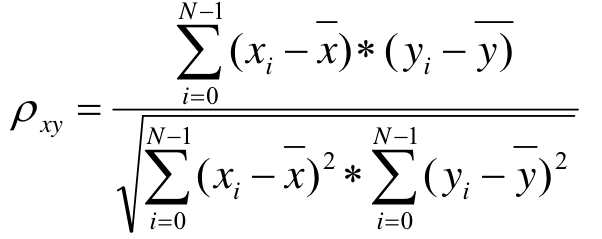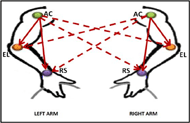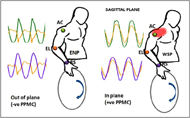CORRELATION ANALYSIS OF UPPER EXTREMITY MOTION DURING MANUAL WHEELCHAIR PROPULSION: A PRELIMINARY INVESTIGATION ON COUPLING BETWEEN ARM SEGMENTS.
Chandrasekaran Jayaramana, Shawna Culpb, Zanxi Anc, Carolyn Becka, Ian M. Riceb, Jacob J. Sosnoffb.
aDepartment of Industrial and Enterprise Systems Engineering, University, bDepartment of Kinesiology and Community Health, cDepartment of Mechanical Engineering. University of Illinois at Urbana-Champaign, Urbana, IL.
ABSTRACT
Although wheelchair propulsion plays a significant role in the development of shoulder pain, minimal differences in propulsion patterns as a function of pain have been noted. Pearson product moment correlation (PPMC) is a classical technique to measure the similarity between two time series However, this technique has been under utilized in wheelchair propulsion research. This cross sectional study is a preliminary investigation which compares the similarity of arm segment joints between novice and experienced manual wheelchair (MW) users. Ten participants were asked to propel a wheelchair mounted on a roller at 3 different speeds (5.4km/hr, 4.5 km.hr and self speed). Results show that propulsion pattern is affected by shoulder pain and PPMC values calculated reflected this between groups.
Method
Of the ten participants 4 were novice users and 6 were experienced users. Two out of the six experienced participants were experiencing shoulder pain (EWP).The movement of the upper body was recorded with a nine- camera motion analysis system. PPMC values were calculated between the sagittal plan displacement data of arm segment joints. The correlations were computed for the intra-arm joints (i.e only within joints of right or left arm) and the inter-arm joints (between right and left joints) .
Summary
The PPMC results obtained from the novice group and experienced group without pain were studied first. Subsequently the PPMC between the experienced group with and without pain were compared to understand the influence of shoulder pain on propulsion pattern. Investigation of pilot data results showed that the EWP group had positive PPMC values while the PPMC values of experienced group without pain (ENP) were negative. Thus in summary the results from our initial study indicate that propulsion pattern is influenced by shoulder pain and experienced MW users with pain tend to alter their propulsion to a more rigid movement.
KEYWORDS
Pearsons product moment correlation, Biomechanics, Kinematics, Wheelchair, Shoulder pain.
INTRODUCTION
Manual wheelchair users are at high risk of developing shoulder pain. Consequently, mechanisms and factors that contribute to shoulder pain in manual wheelchair users have been a topic of scientific inquiry. Researchers and healthcare providers have prescribed recommendation on the various parameters of wheelchair design and kinematic and kinetic propulsion factors related to shoulder pain (Boninger, 2005). However there has been less focus on the coupling between arm segments during wheelchair propulsion. There are numerous ways to examine coupling in a biomechanical system. A traditional approach is the Pearson product moment correlation (PPMC). The reliability of PPMC to study walking behavior is well known (Derrick, 1994; Stergiou, 1999). Importantly, this technique provides complementary information to traditional kinematic analysis. To our knowledge, there has been no application of the PPMC method to study wheelchair propulsion. The purpose of this study was to examine coupling of the upper extremity during wheelchair propulsion in novice and experienced manual wheelchair users. Additionally, we examined whether correlational analyses are sensitive to shoulder pain in wheelchair users.
METHOD
Participants
10 participants from the Urbana-Champaign community with an average of 21 ± 2 years were recruited for this study. All subjects provided informed consent after verbal explanation of the IRB approved experimental procedures. To be included in the study as an experienced wheelchair users participants had to use a manual wheelchair as their primary means of mobility for more than 1 year. Novice wheelchair users did not have shoulder pain and had no experience propelling a manual wheelchair.
Of the 10 participants 4 were novice users and 6 were experienced users. Two out of the six experienced participants had shoulder pain (EWP).
Experimental Protocol
After providing consent, participants provided demographic information (age, gender, etc). Wheelchair users also provided information concerning their disability and shoulder pain. Shoulder pain was indexed with the wheelchair user shoulder pain index (WUSPI) (Curtis, 1995).
Once demographic information was provided 18 retro- reflective markers were placed on the participants. Placements were based on the ISB suggested upper body marker standard and were the right and left ulnar styloids (US), right and left second metacarpal heads (2ND), right and left radial styloids (RS), right and left acromion processes (AC), suprasternal notch (IJ or SC), xyphoid process (PX), right and left lateral epicondyles (EL), right and left medial epicondyles (EM), right and left glenohumeral centers of rotation (GH), posterior C7 (C7) and posterior T8 (T8). Additional markers were placed on wheelchair hub.
Novice wheelchair users used a standard wheelchair, and expert wheelchair users used their own wheelchairs. A resistive roller was placed below the wheels of wheelchairs. The wheel centres were aligned with the roller centre. The wheelchair was secured safely on a custom developed dynamometer platform. A speedometer was placed in front of subjects to let them know their current speed of propulsion. Figure 1 shows the detailed experimental setup
Once in position the participant was asked to push the wheels on roller to obtain familiarity with the roller system. The participant was then asked to push on the roller at a comfortable pace. This comfortable steady state speed reached was noted to be the self selected pace. The participants were asked to propel at constant speeds of 5.4km/h (fast), 4.5km/h (medium), as well as theself- selected speed, for two minutes.
The sequence speeds was randomized across subjects. Before each trial began, the subject was asked to push at the designated speed to become accustomed to the pace.
Motion Capture System
The kinematic data were collected using motion capture equipment (Cortex 2.5, Motion Analysis Co.; CA, USA) at 100Hz. 9 cameras were used to capture the motion. Global coordinates were set with positive x-axis pointing posterior and positive z-axis pointing vertically up. The direction of y-axis was that of a vector calculated from z- axis unit vector cross x-axis unit vector (right-hand coordinate), such that positive y-axis was pointing to the subject’s right side.
Post Processing
 Figure 1: Experimental set up with dynamometer and the reflective marker positions. d
Figure 1: Experimental set up with dynamometer and the reflective marker positions. dThe motion data were post processed to remove the DC component and then filtered with a Fourier band pass filter of 0.2 Hz to 15 Hz to remove noise and high frequency components from the signals (Cooper, 2002). Only the sagittal plane (X direction) displacement data was considered for analysis in this study as the dominant motion during wheelchair propulsion is connected to that plane (X direction). MATLAB (R2009a, The MathWorks; Natick, MA, USA) was used for all computation work in this study.
DATA ANALYSIS
Only sagittal plane data from arm segment markers (RS, US, AC, EL) were correlated and are discussed henceforth.
Pearson Product Moment Correlation (PPMC)
The PPMC is a simple measure of temporal similarity of two curves. This correlation is usually performed at zero lag. In statistical terms the PPMC is defined as the degree to which x and y (the two time series to be correlated) vary together divided by the degree to which x and y vary separately.

 Figure 2: Different inter-arm and intra-arm joints between which PPMC was computed.AC (Acromion), EL (Lateral epicondyle) and RS(Radial Styloid). Dotted line shows the inter-arm joints and solid line shows the intra-arm joints for which PPMC was computed. d
Figure 2: Different inter-arm and intra-arm joints between which PPMC was computed.AC (Acromion), EL (Lateral epicondyle) and RS(Radial Styloid). Dotted line shows the inter-arm joints and solid line shows the intra-arm joints for which PPMC was computed. d The version of the PPMC most commonly used is where ρ![]() xy is the PPMC between the series x and y, x and y are the mean of the respective timeseries. Only the stationary part of the time series was considered for the computation of PPMC. To find this partition of the data, the variation of the mean with respect to time (m(t)) of the raw signal from each time series was plotted. Only the portion of the time series which had approximatelyconstant m(t) was chosen for computing the PPMC. In simpler terms, to satisfy the condition of stationarity the first 15 seconds of data collected in each trial was removed and the analysis was carried out on the remaining 105 second of time series data. The PPMC was computed for both inter-arm and intra- arm left and right segments. Figure 2 shows the different inter-arm and intra-arm points for which PPMC was computed.
xy is the PPMC between the series x and y, x and y are the mean of the respective timeseries. Only the stationary part of the time series was considered for the computation of PPMC. To find this partition of the data, the variation of the mean with respect to time (m(t)) of the raw signal from each time series was plotted. Only the portion of the time series which had approximatelyconstant m(t) was chosen for computing the PPMC. In simpler terms, to satisfy the condition of stationarity the first 15 seconds of data collected in each trial was removed and the analysis was carried out on the remaining 105 second of time series data. The PPMC was computed for both inter-arm and intra- arm left and right segments. Figure 2 shows the different inter-arm and intra-arm points for which PPMC was computed.
RESULTS
Table 1,Table 2 and Table 3 lists the values of PPMC as a function of group ( novice and experienced (without pain)) for fast, medium and self selected speed trials respectively. The average PPMC values from the left and right intra-arm joints are listed in the first and second column of each table respectively. The third column in each table lists the average PPMC values between the inter-arm joints. The PPMC values for the novice group was consistently positive (around +0.6) between the inter-arm and intra-arm segment joints. The experienced group without shoulder pain had consistent high negative PPMC values (around -0.8) between the intra-arm and inter-arm segment joints. These PPMC results were observed consistently at all three speed ranges.
 Figure 3: In-phase and out-of-phase displacement motion data at different joints between ENP( experienced no pain) and WSP (experienced with shoulder pain) group. d
Figure 3: In-phase and out-of-phase displacement motion data at different joints between ENP( experienced no pain) and WSP (experienced with shoulder pain) group. dOnce it was determined that PPMC values were sensitive to differences between experienced and novice wheelchair users, it was of interest to investigate if the PPMC was sensitive to the difference in propulsion pattern between experienced users with and without pain. The data in the second and third rows of Table 1,Table 2 and Table 3 lists the average values of PPMC for the experienced users with and without pain respectively.
Group |
Avg PPMC of all left intra- arm points. |
Avg PPMC of all right intra- arm points. |
Avg PPMC of all inter-arm points. |
|---|---|---|---|
Novice |
0.65 |
0.63 |
0.62 |
Exper. |
-0.78 |
-0.79 |
-0.8 |
Experience Pain |
0.93 |
0.83 |
0.88 |
Group |
Avg PPMC of all left intra- arm points. |
Avg PPMC of all right intra- arm points. |
Avg PPMC of all inter-arm points. |
|---|---|---|---|
Novice |
0.69 |
0.58 |
0.57 |
Exper. |
-0.75 |
-0.74 |
-0.76 |
Experience Pain |
0.79 |
0.89 |
0.84 |
| Group | Avg PPMC of all left intra- arm points. | Avg PPMC of all right intra- arm points. | Avg PPMC of all inter-arm points. |
|---|---|---|---|
| Novice | 0.56 | 0.59 | 0.57 |
| Exper. | -0.82 | -0.79 | -0.81 |
| Experience Pain | 0.77 | 0.92 | 0.78 |
The experienced group with pain (EWP) had a high positive correlation ( around +0.9) as compared to the other experienced group. Figure 3 is graphical representation of displacement phase relations at joints between the experienced group with and without shoulder pain. The ENP groups curve are out-of-phase while the EWP curves show in-phase relations.
DISCUSSION
The purpose of this investigation was to examine coupling of arm joint segments as a function of experience and shoulder pain during wheelchair propulsion. Distinct differences in coupling of arm segments between experienced and novice users was found as were differences between experienced users with and without pain. The factors contributing to these differences are discussed below.
The observation of the distinct coupling between novice and experienced groups suggests that these groups demonstrate distinct patterns. It is well known that experienced wheelchair users execute a looping pattern (Shimada, 1998) while novice users tend to utilize an inefficient chopping like pattern. The PPMC value obtained between these no pain groups could be a measure which reflects these pattern differences.
The different coupling between experienced users with and without pain suggest that pain contributes to different coupling patterns between arm segments. Essentially, the participants with pain demonstrate a more rigid movement pattern. This rigid movement pattern is analogous to a lower extremity limb. It was also observed that experienced users with pain demonstrate greater PPMC values than the novice group. This observation suggests that although experienced users present different upper body coupling they are do not adopt a novice pattern.
Although the reported values are averages, a similar trend was observed in the individual values of each participant. Further investigation is needed to report if the PPMC values obtained could be attributed to the degree of the shoulder pain experienced or the type of injury. It would also be interesting to study the mechanics of the EWP group as they transition from a negative PPMC to a positive PPMC.
Limitations
This study was a preliminary investigation and although the results are promising there are some limitations. The small sample size, especially in the pain and no pain groups suggests that caution should be utilized and the data should be generalized. The cross-sectional nature of the data precludes any cause and effect conclusions. But nevertheless it is interesting to note that a classical technique like the PPMC could provide valuable information concerning wheelchair propulsion and identify group differences.
CONCLUSIONS
This preliminary investigation hypothesized that a strong propulsion pattern difference exists between experienced and novice wheelchair users. This was quantified by the trend of PPMC values computed from motion capture data of different groups. The coupling between the different arm segments of experienced users with and without pain contributes to different propulsion patterns which could be identified from the PPMC values of groups. The experienced group with pain demonstrated stronger positive PPMC values than the novice group, suggesting the difference in pattern between their propulsion. The PPMC values of the experienced group with and without pain showed opposite trends. We feel that the strength of our measures was reduced because of the small number of subjects representing each group. We anticipate future analyses involving a larger and a more diverse group of subjects.
REFERENCES
Boninger, ML., Souza, AL., Cooper, RA., Fitzgerald, SG., Koontz, AM., Fay, BT.(2002). Propulsion patterns and pushrim biomechanics in manual wheelchair propulsion. Arch Phys Med Rehabil May;83(5):718-23.
Boninger, ML., Koontz, AM., Sisto, SA., Hudson, TAD., Chang, M., Price, R. (2005). Biomechanics and injury prevention in spinal cord injury:Recommendations based on CULP-SCI investigations. JRRD, Volume 42, Number 3, Supplement 1.
Curtis, KA., Roach, KE., Applegate, EB., Amar, T., Benbow, CS., Genecco, TD., Gualano, J., (1995). Development of wheelchair User’s shoulder pain index. Paraplegia. 33(5):290-3.
Derrick, TR., Bates, BT., Dufek, JS., (1994). Evaluation of time series data using the pearsons product moment correlation coefficient.Medicine and science in sports and exercise, 26(7): 919-928.
Koontz, A. M., Cooper, R. A., Boninger, M. L., Souza, A. L., & Fay, B. T. (2002). Shoulder kinematics and kinetics during two speeds of wheelchair propulsion. Journal of Rehabilitation Research and Development, 39(6), 635-649.
Shimada, SD., Robertson, RN., Bonninger, ML., Cooper, RA., (1998).Kinematic characterization of wheelchair propulsion. Journal of Rehabilitation Research and Development, 35( 2): 210-218.
Stergiou, N., Bates, BT., and James, SL., (1999). Asynchrony between subtalar and knee joint function during running. Medicine and science in sports and exercise, 31(11):1645-1655.
ACKNOWLEDGEMENTS
The study is supported by the National Institute of Health grant #1R21HD066129-01A1. The authors would also like to thank Mike Socie, AJ Hermann, Katie White and Scott Daigle for their assistance in experimental preparation and data collection.